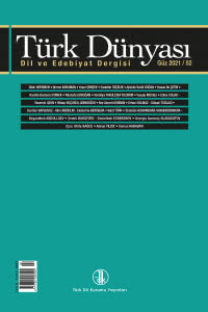KIRGIZ KÜLTÜRÜNDE KUT KAVRAMININ ÖZELLİKLERİ
Türkçenin en eski dönemlerinden itibaren günümüze kadar bütün
Anahtar Kelimeler:
Kırgız Türkçesi, Orhun Türkçesi, Eski Uygur Türkçesi, kültür, kut, kıw
Features of the Concept of “Kut” in Kirghiz Culture
According to the research carried out on the basis of the etymologicaldictionaries, the word Kut, which has existed in all historical andmodern Turkic dialects since the oldest periods of Turkish, has a lot ofmeaning that changes depending on the period and dialect. In the Kyrgyzculture, we found that the concept of kut ‘happiness’ consists of aspectsof the abstract-concrete, external and internal world. The abstract planeconsists of such concepts as “god” and “luck”, which are associated withthe perception of people of the outside world and such as “soul”, “spirit”,“heart”, “life energy”, which are associated with the perception of theirinner world. We found that a specific plane consists of tangible objects,such as “talisman”, “idol”. The word kut in the general Turkic languagecontains the traces of the ancient Türkic faith and carries in itself as anabstract plane expressing «luck», «will», «happiness», which people believethey receive from God, and the expression of a concrete plan, as aguardian, which in reality, is no longer used in everyday life as an instrumentof protection against the evil eye because of the influence ofIslamic beliefs. It became clear that the amulet, which until recently existedamong the Kyrgyz but whose specimens are found today only amongthe Siberian people, and made of blue or red cloth, symbolizes the YağızYer and Kök Teñri existing in the old Turkic beliefs. As in other Turkicpeople, it can be seen that the word kut is used both in the names of boysand girls, because it expresses a positive meaning in the language.
Keywords:
Kirghiz language, Orkhon Turkish, Old Uighur Language, culture, Turkic ‘kut’, ‘kıw’,
___
- Abduldayev, E. ve diğerleri (1965). Kırgız Dilinin Açıklamalı Sözlüğü (Kırgız Tilinin Tüşündürmö Sözdüğü). Frunze: Mektep.
- Batislam, H. Dilek (2002). “Divan Şiirinin Mitolojik Kuşları: HÜMÂ, ANKA VE SİMURG”. Türk Kültürü İncelemeleri Dergisi, 185-208.
- Bitikçi, Eleri (2017). “40 Elementov Kırgızskoy Kulturı”. Kod Kırgızov, Akipress elektronik gazetesi: http://kgcode.akipress.org/unews/un_post:9112 erişim tarihi: 08.03.2018
- Bogenbayev, N; Calmırza, A. (2014). “Eski Türk Dünya Görüşündeki “Kut” ve “Karga” kavramları”. Milli Folklor Dergisi, 26, 103.
- Caparov, Ş. (2004). Adam Attarı -El Baylıgı. Bişkek.
- Çelik Şavk, Ü. (2002). Kırgız Atasözleri. Ankara: TDK Yayınları.
- Ercilasun, A. B. (2016). Türk Kağanlığı ve Türk Bengü Taşları. İstanbul: Dergâh Yayınları.
- Gülensoy, T. (2011). Türkiye Türkçesindeki Türkçe Sözlüklerin Köken Bilgisi Sözlüğü. C 1, Ankara: TDK Yayınları.
- Findley, C. V. (2008). Dünya Tarihinde Türkler. İstanbul: Kitapyayınevi.
- Hargitai, Q. (2018). “Nazarlığın Tarihsel Kökeni Nereye Dayanıyor?”. BBC Culture: www. bbc.com/turkce/vert-cul-43116420 erişim tarihi:08.03.2018.
- İsi, H. (2018). Eski Uygur Türkçesinde “Kut Kıv” İkilemesinde Geçen “Kıv” Sözcüğünün Tarihi Metinlerinden Türkiye Türkçesine Serüveni”. Dede Korkut Dergisi, 15, C 7, 32-53.
- Karakaş, S. (2018). “Kut-Tanrı İlişkisi Bağlamında Türklerde Yönetim Erkinin İlâhî Temelleri”. KUT (Editör: Yaşar Kalafat), Ankara: Berikan Yayınları.
- Levitskya, L. S. ve diğerleri (2000). Türk Dillerinin Etimolojik Sözlüğü (Etimolojiçeskiy slovar tyurkskix yazıkov). Moskva: Nauka Yayınları.
- Nadelyaev, V. M. ve diğerleri (1969). Eski Türkçe Sözlük (Drevnetyurkskiy Slovar’). Leningrad: Nauka Yayınları.
- Nayzabekova, A. (2016). Kırgız Uluttuk Oymo. Bişkek: Arip-Press Basımevi.
- Orozbayev, M. (2014). Kırgızcadaki İslam Öncesi Geleneksel İnanç ve İnanışlarla İlgili Söz Varlığı, Ankara: TDK Yayınları.
- Osmonova, C. ve diğerleri (2001). Kırgız Tilinin Frazeologiyalık Sözdüğü. Bişkek, Manas Üniversitesi.
- Tekin, T. (1998) Orhun Yazıtları. İstanbul: Simurg Yayınları.
- Yudahin, K. (1985a). Kırgızca-Rusça Sözlüğü. C 1, Frunze: Kırgız Ansiklopedisi Yayınları.
- Yudahin, K. (1985b). Kırgızca-Rusça Sözlüğü. C 2, Frunze: Kırgız Ansiklopedisi Yayınları.
- ISSN: 1301-0077
- Yayın Aralığı: Yılda 2 Sayı
- Başlangıç: 1996
- Yayıncı: Türk Dil Kurumu
Sayıdaki Diğer Makaleler
İZMİR İLİ ÖDEMİŞ-KİRAZ-BEYDAĞ İLÇESİ AĞIZLARININ TEMEL ÖZELLİKLERİ
1944 SÜRGÜNÜ SONRASI ÖZBEK TÜRKÇESİNDEN KIRIM TATAR TÜRKÇESİNE GEÇEN KELİMELER ÜZERİNE BİR İNCELEME
KIRGIZ KÜLTÜRÜNDE KUT KAVRAMININ ÖZELLİKLERİ
MÖHEMMET MEHDİYEV’İN TURNALARIN İNDİĞİ YERDE ADLI ROMANINDA KAZAN TATAR GELENEKLERİ
TURFAN BÖLGESİNDEKİ ESKİ UYGUR YER ADLARI
KAFKASYA’DA 19. YÜZYILDA TÜRKÇE HALK KÜLTÜRÜ DERLEMELERİ
